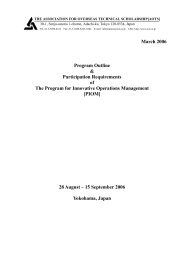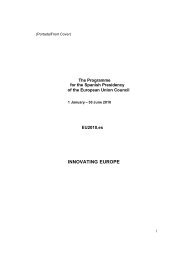Analysis of the Operation and Financial Condition of the Enterprise
Analysis of the Operation and Financial Condition of the Enterprise
Analysis of the Operation and Financial Condition of the Enterprise
You also want an ePaper? Increase the reach of your titles
YUMPU automatically turns print PDFs into web optimized ePapers that Google loves.
<strong>Analysis</strong> <strong>of</strong> <strong>the</strong> <strong>Operation</strong> <strong>and</strong> <strong>Financial</strong> <strong>Condition</strong> <strong>of</strong> <strong>the</strong> <strong>Enterprise</strong>Net current assets that are at <strong>the</strong> disposal <strong>of</strong> an enterprise can convince creditors infavour <strong>of</strong> lending <strong>the</strong> resources to <strong>the</strong> enterprise. Net current assets provide a significantfinancial freedom for an enterprise in a situation <strong>of</strong> an increased rate <strong>of</strong> turnover <strong>of</strong> currentassets, impairment or loss <strong>of</strong> <strong>the</strong> value <strong>of</strong> assets.Optimal amount <strong>of</strong> <strong>the</strong> working capital depends on several factors: area <strong>of</strong> operations <strong>of</strong> an enterprise; size <strong>of</strong> an enterprise – <strong>the</strong> scope <strong>of</strong> production or sales; <strong>the</strong> terms <strong>of</strong> <strong>the</strong> enterprise crediting; speed <strong>of</strong> stock turnover; debtors collection period.4.3. Solvency measuresSolvency is one <strong>of</strong> <strong>the</strong> most significant criteria in assessment <strong>of</strong> <strong>the</strong> financialposition <strong>of</strong> an enterprise. It describes <strong>the</strong> situation when an enterprise has sufficient cashassets to settle at a short notice <strong>the</strong>ir open transactions with creditors, while <strong>the</strong> potentialcreditors after <strong>the</strong> assessment <strong>of</strong> <strong>the</strong>se measures want to find out to what extent <strong>the</strong>enterprise is dependent on <strong>the</strong> capital borrowed or to what extent can it rely on its owncapital. These measures are especially important for assessment <strong>of</strong> <strong>the</strong> capacity to borrow<strong>of</strong> an enterprise. If <strong>the</strong> amount <strong>of</strong> liabilities is excessive an enterprise could be in danger <strong>of</strong>insolvency.The main features <strong>of</strong> insolvency are thus as follows: Sufficient amount <strong>of</strong> cash on <strong>the</strong> current bank account <strong>and</strong> in till; Due repayment <strong>of</strong> creditors debts.It has to be noted that <strong>the</strong> recommendable amounts should not be taken literally.There are situations when <strong>the</strong> share <strong>of</strong> equity from <strong>the</strong> total may be less than a half,however, <strong>the</strong> enterprise will still maintain high financial stability. This, first <strong>of</strong> all, is truein respect <strong>of</strong> enterprises with <strong>the</strong> operations related to a high asset turnover, permanentdem<strong>and</strong> for <strong>the</strong> goods for sale, well managed contacts with customers <strong>and</strong> sellers, <strong>the</strong> lowlevel <strong>of</strong> fixed costs (for example, trade <strong>and</strong> brokerage entities).This group <strong>of</strong> measures describes <strong>the</strong> asset structure. They are designed to: establish <strong>and</strong> describe <strong>the</strong> relationship <strong>of</strong> liabilities against <strong>the</strong> equity or <strong>the</strong>total amount <strong>of</strong> assets; assess <strong>the</strong> ability <strong>of</strong> an enterprise to increase its amount <strong>of</strong> debt; assist in <strong>the</strong> assessment <strong>of</strong> <strong>the</strong> ability <strong>of</strong> a firm to meet its debts on due date.The measures <strong>of</strong> this group reflect <strong>the</strong> ability <strong>of</strong> an enterprise to repay its long-term<strong>and</strong> short-term liabilities. These measures are especially important for existing <strong>and</strong> also forpotential creditors as <strong>the</strong>y show to what extent <strong>the</strong> revenue <strong>of</strong> an enterprise cover <strong>the</strong>interest <strong>and</strong> o<strong>the</strong>r fixed payments, as well as whe<strong>the</strong>r in <strong>the</strong> case <strong>of</strong> enterprise liquidation<strong>the</strong>re are sufficient assets to repay its debts. Shareholders are interested in this measure,because <strong>the</strong> accrued interest is considered to be an expense that increases <strong>the</strong> liabilities <strong>of</strong>an enterprise. If <strong>the</strong> amount <strong>of</strong> loans <strong>and</strong>, <strong>the</strong>refore, also <strong>the</strong> amount <strong>of</strong> interest payable isexcessive, <strong>the</strong> enterprise may face <strong>the</strong> bankruptcy procedure.72
















